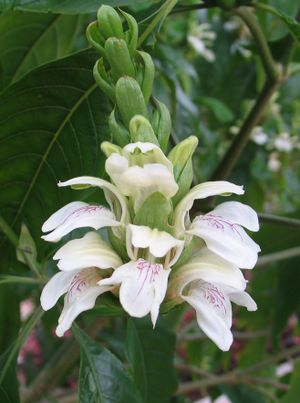Note: This is a project under development. The articles on this wiki are just being initiated and broadly incomplete. You can Help creating new pages.
Justicia adhatoda - Simhaparni
Simhaparni is sanskrit name of Adhatoda Zeylanica Medikus (Botanical Name). Simhaparni commonly known in English as Malabar Nut is a medicinal plant native to Asia, widely used in Siddha Medicine, Ayurvedic, homeopathy and Unani systems of medicine. The plant's range includes Sri Lanka, Nepal, India, Pakistan, Indonesia, Malaysia, and China, as well as Panama where it is thought to have been introduced.
Uses
Joint Pain, Cuts, cough, skin itchiness, respiratory disorders, asthma, abnormal bleeding, peptic ulcers, piles
Parts Used
Chemical Composition
dhatoda zeylanica contains a number of chemical constituents which are responsible to cure many diseases and disorders. Generally leaves contain more chemicals as pyrroloquinazoline alkaloids, vasicine, vasicol, adhatonine, vasicinone, vasicinolone, vasicinol [1]
Common names
| Language | Common name |
|---|---|
| Kannada | aadu muttada gida, aadu soge |
| Hindi | adusa, vasak |
| Malayalam | adel-odagam, |
| Tamil | aadaathodai, acalai |
| Telugu | addasaramu, addasarapaku |
| Marathi | NA |
| Gujarathi | NA |
| Punjabi | NA |
| Kashmiri | NA |
| Sanskrit | arus, vajidantakahaatarusha |
| English |
Habit
Identification
Leaf
| Kind | Shape | Feature |
|---|---|---|
| Simple | 10-30 cm long | Lanceolate to ovate-lanceolate, slightly acuminate, base tapering, petiolate, petioles 2-8 cm long, exstipulite, glabrescent |
Flower
| Type | Size | Color and composition | Stamen | More information |
|---|---|---|---|---|
| Unisexual | 2-4cm long | purpule | 5-20 | The flowers are hermahrodite. The corolla is large and white with a funnel shaped lower portion, the lower lip of corolla is streaked purpule |
Fruit
| Type | Size | Mass | Appearance | Seeds | More information |
|---|---|---|---|---|---|
| somple | 7–10 mm (0.28–0.4 in.) long pome | The fruit is a small capsule | With hooked hairs | {{{6}}} |
Other features
List of Ayurvedic medicine in which the herb is used
- Vishatinduka Taila as root juice extract
Where to get the saplings
Mode of Propagation
How to plant/cultivate
Easily grown in most soils[21][22], preferring a calcareous soil. Thrives in a dry lightly shaded position[16], though it prefers full sun. Plants usually self-sow quite freely when growing in a suitable position[19]. The seeds are contained in burrs that can easily attach themselves to clothing or animal's fur, thus transporting them to a new area where they can germinate and grow.The cultivar 'Sweet scented' is popular in France for making tea because the whole plant is sweet scented and the flowers have a spicy apricot-like fragrance.
Commonly seen growing in areas
Photo Gallery
References
External Links
- Pages that are stubs
- Ayurvedic Herbs known to be helpful to treat Joint Pain
- Ayurvedic Herbs known to be helpful to treat Cuts
- Ayurvedic Herbs known to be helpful to treat cough
- Ayurvedic Herbs known to be helpful to treat skin itchiness
- Ayurvedic Herbs known to be helpful to treat respiratory disorders
- Ayurvedic Herbs known to be helpful to treat asthma
- Ayurvedic Herbs known to be helpful to treat abnormal bleeding
- Ayurvedic Herbs known to be helpful to treat peptic ulcers
- Ayurvedic Herbs known to be helpful to treat piles
- Herbs with Root used in medicine
- Herbs with Leaf used in medicine
- Herbs with Stem used in medicine
- Herbs with Flower used in medicine
- Herbs with common name in Kannada
- Herbs with common name in Hindi
- Herbs with common name in Malayalam
- Herbs with common name in Tamil
- Herbs with common name in Telugu
- Herbs with common name in Sanskrit
- Habit - Shrub
- Index of Plants which can be propagated by Seeds
- Index of Plants which can be propagated by Cuttings
- Herbs that are commonly seen in the region of Himalayans
- Herbs that are commonly seen in the region of tropical
- Herbs that are commonly seen in the region of malesia, Shri lanka
- Herbs



